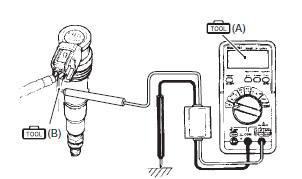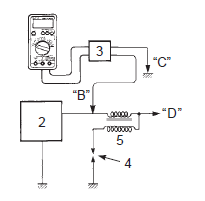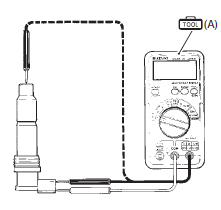Suzuki GSX-R 1000 Service Manual: Ignition coil inspection
Refer to “electrical components location” in section 0a .
Ignition coil primary peak voltage
- Remove the air cleaner box. Refer to “air cleaner box removal and installation” in section 1d .
- Disconnect all ignition coil. Refer to “ignition coil and spark plug removal and installation” .

- Connect the new spark plugs to each ignition coil.
- Connect all the ignition coil lead wire couplers to the ignition coil respectively, and ground them on the cylinder head (each spark plug hole).
| Caution avoid grounding the spark plugs and suppling the electrical shock to the cylinder head cover (magnesium parts) to prevent the magnesium material from damage. |
| Note be sure that all the spark plugs are connected properly and the battery used is in fully-charged condition. |

|
- Insert the needle pointed probe to the lead wire coupler.
| Caution use the special tool to prevent the rubber of the water proof coupler from damage. |
- Connect the multi-circuit tester with the peak voltage adaptor as follows.
| Caution before using the multi-circuit tester and peak voltage adaptor, refer to the appropriate instruction manual. |
Special tool
 (a): 09900–25008 (multi circuit
(a): 09900–25008 (multi circuit
tester set)
 (b): 09900–25009 (needle-point
(b): 09900–25009 (needle-point
probe set)
Tester knob indication: voltage (
)



|
- Measure the ignition coil primary peak voltage in the following procedures:
 Do not Do not
touch the tester probes and spark plugs to prevent an electric shock while testing. |
- Shift the transmission into neutral, turn the ignition switch on and grasp the clutch lever.
- press the starter button and allow the engine to crank for a few seconds, and then measure the ignition coil primary peak voltage.
- Repeat the b) procedure several times and measure
the highest peak voltage.
If the voltage is lower than standard range, inspect the ignition coil and the ckp sensor.
Ignition coil primary peak voltage 80 v and more
- After measuring the ignition coil primary peak voltage, reinstall the removed parts.
Ignition coil resistance
- Remove the ignition coil. Refer to “ignition coil and spark plug removal and installation” .
- Measure the ignition coil for resistance in both primary and secondary coils. If the resistance is not within the standard range, replace the ignition coil with a new one.
Special tool
 (a): 09900–25008 (multi circuit
(a): 09900–25008 (multi circuit
tester set)
Tester knob indication resistance (Ω)
Ignition coil resistance primary: 1.1 – 1.9 Ω ((+) terminal – (–) terminal) secondary: 6.4 – 9.6 KΩ (spark plug cap – (–) terminal)


- After measuring the ignition coil resistance, reinstall the removed parts.
 Ignition coil and spark plug removal and
installation
Ignition coil and spark plug removal and
installation
Removal
The hot
engine can burn you.
Wait until the engine is cool enough to touch.
Turn the ignition switch off.
Remove the air cleaner box. Refer to “air cleaner box ...
 Ckp sensor inspection
Ckp sensor inspection
Refer to “electrical components location” in section 0a .
Ckp sensor peak voltage
Lift and support the fuel tank. Refer to “fuel tank
removal and installation” in section 1g (page 1g-
9).
D ...
Other materials:
Rear wheel dust seal / bearing removal and installation
Removal
Remove the rear wheel assembly. Refer to “rear wheel assembly removal
and installation” .
Remove the rear sprocket mounting drum assembly
(1) from the rear wheel.
Remove the wheel dampers (2).
Remove the dust seal.
Special tool
(a): 09913–50121 (oil s ...
Specifications
Service data
Electrical
unit: mm
Tightening torque specifications
Note
the specified tightening torque is described in the following.
“Starter motor components”
Reference: for the tightening torque of fastener not specified in this
section, refer to “tightening to ...
Air bleeding from brake fluid circuit
Air trapped in the brake fluid circuit acts like a cushion to
absorb a large proportion of the pressure developed by
the master cylinder and thus interferes with the full
braking performance of the brake caliper. The presence
of air is indicated by “sponginess” of the brake lever and
also by la ...

 Contact
Contact